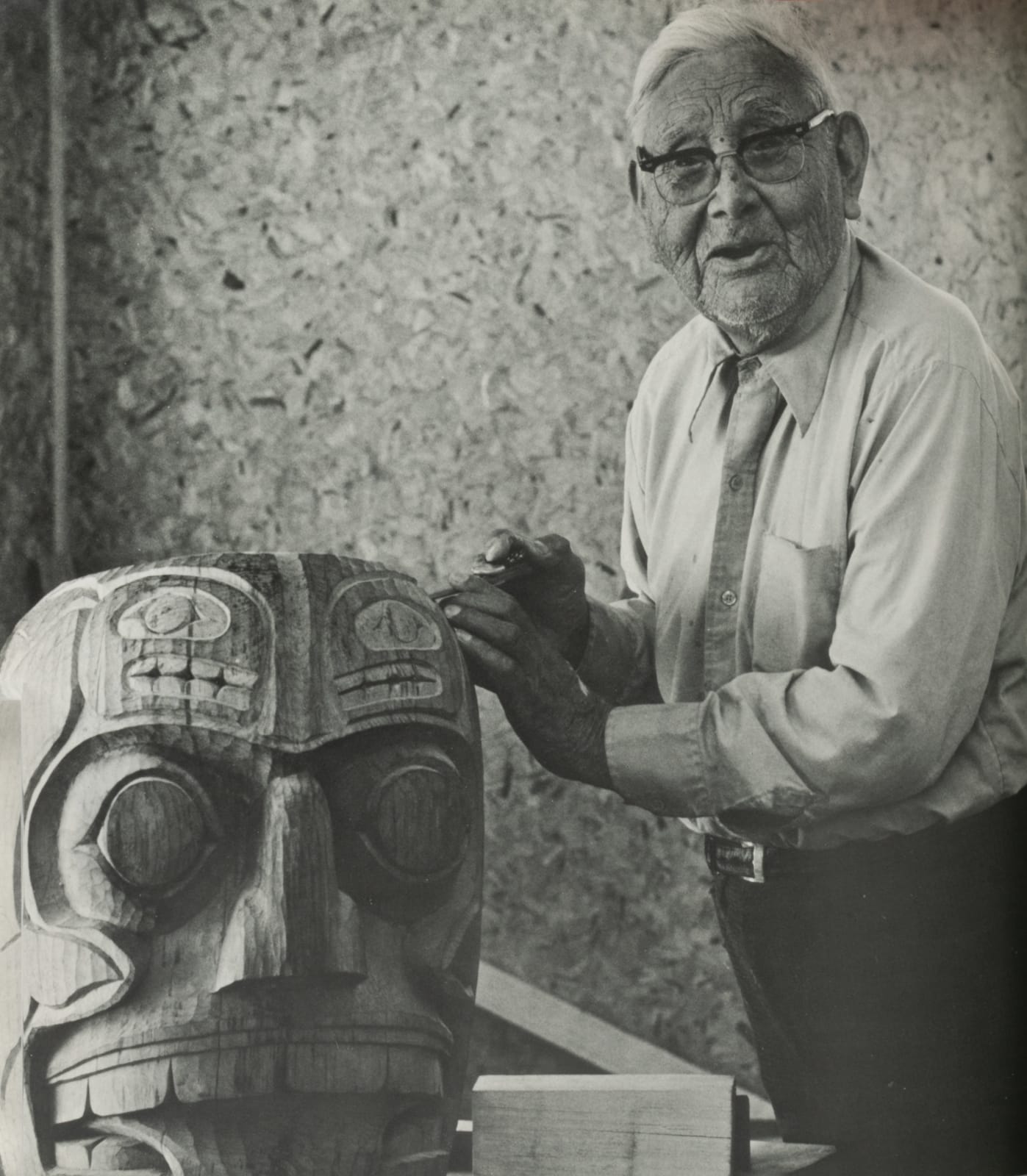-
Artworks
Open a larger version of the following image in a popup: "Born in Friendly Cove, Jimmy John has lived in Cedar, near Nanaimo, for half a century. Close to a hundred years old, he is a direct descendant of Chief Maquinna."
"Born in Friendly Cove, Jimmy John has lived in Cedar, near Nanaimo, for half a century. Close to a hundred years old, he is a direct descendant of Chief Maquinna."
Ulli Steltzer, Indian Artists at Work, (Vancouver: J.J. Douglas, 1976), pg 82.JIMMY JOHN (1876-1988), MOWACHAHT/MUCHALAHT (NUU-CHAH-NULTH)
Maquinna Mask , c. 1973-1975cedar wood, abalone, pigment, and cord, 34.5 x 45.5 x 15.75 in (87.6 x 115.6 x 40 cm)
unsigned;
accompanied by a copy of Ulli Steltzer, "Indian Artists at Work" (1976).LOT 137
ESTIMATE: $12,000 — $18,000
PRICE REALIZED: $18,300.00Further images
Renowned Mowachaht/Muchalaht artist Jimmy John was born at Friendly Cove, British Columbia, and was a direct descendant of Chief Maquinna. John created pieces for cultural usage and sale for nearly...Renowned Mowachaht/Muchalaht artist Jimmy John was born at Friendly Cove, British Columbia, and was a direct descendant of Chief Maquinna. John created pieces for cultural usage and sale for nearly a century and was among the most prolific and long-standing artists on the entire Pacific Northwest Coast. Known primarily for his model totem poles and a distinctive chip carving style that he developed in his older age, John’s works are widely held in major public and private collections.
This Maquinna Mask has to be among John’s best-known works, having been photographed with him in the process of carving it by celebrated photographer Uli Steltzer (1923-2018). That photograph - of a smiling, near-centenarian Jimmy John working on the unfinished mask - is published by Steltzer on page 82 in her photo essay book Indian Artists at Work (1976). Although the mask is unfinished in the Steltzer photo, several key elements allow this mask to be matched to the photograph. In particular, there is a large fissure in the photo where the wood is checking through the head of the killer whale on the proper right side of the mask, which can be matched today to a darker line in the same place where John fixed the checking. There is also a dark spot visible in the Steltzer photograph on the upper-right tooth of the mask, which is still present in the mask today.
The completed mask is a striking composition and important study in Jimmy John’s chip-carving style, with twenty kinetic appendages that are strung together to open and close in a dramatic fashion. Each appendage is incised with an eagle formline design, cross hatching, and split-u-forms that terminate in a rounded semi-circle. At the top of the mask are two raven figures back-to-back with inlaid abalone and red flourishes that anchor the other ten appendages on each side. The mask itself is flanked by a pair of killer whales carved in relief that frame the shape of the forehead and cheeks of the mask. The bulging eyes, bared teeth, and protruding tongue point to the mask probably being John’s interpretation of a Swai’xwe mask. The features of the mask are accentuated with abalone inlays and red and black paint, which enhances its theatrical impact.
Christopher W. Smith
References: See the Anthony Carter fonds, Series 03, File 04, in the archival holdings of the Museum of Anthropology, University of British Columbia, for additional photos of Jimmy John with a similar Maquinna Mask in 1968. For other works by or attributed to the artist see Martha Black, HuupuKwanum Tupaat : Out of the Mist: Treasures of the Nuu-chah-nulth Chiefs, (Victoria, BC: Royal British Columbia Museum, 1999), pp. 83, 107, 111.Provenance
Collection of the artist;
Purchased from the Artist's Family, c. 1992 by the Present Private Collection, Ottawa.Publications
This work is reproduced in a photo of the artist working on the present mask in Ulli Steltzer, Indian Artists at Work, (Vancouver: Douglas & McIntyre / Seattle: University of Washington Press, 1976), p. 84
Join our mailing list
* denotes required fields
We will process the personal data you have supplied in accordance with our privacy policy (available on request). You can unsubscribe or change your preferences at any time by clicking the link in our emails.












